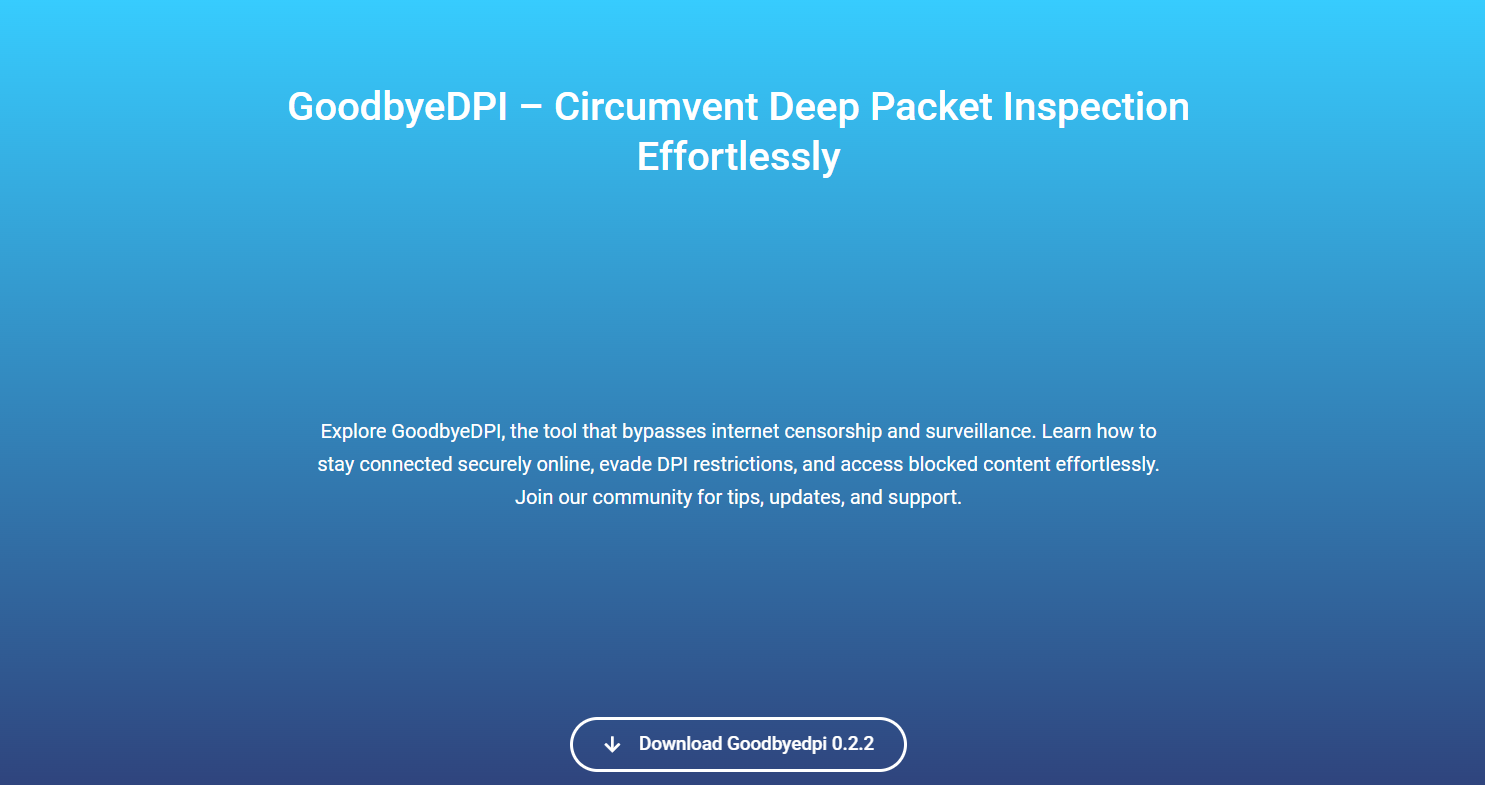Is GoodbyeDPI Effective Against ISP Throttling?

Internet Service Providers (ISPs) have long used various methods to control and monitor user traffic on their networks. One common technique is ISP throttling, where certain types of internet traffic are deliberately slowed down to manage bandwidth or enforce content restrictions. This practice can frustrate users, especially those who rely on consistent and fast connections for streaming, gaming, or accessing censored content.
Enter GoodbyeDPI, a specialized utility designed to bypass a sophisticated form of traffic filtering called Deep Packet Inspection (DPI). Since DPI is often the backbone technology ISPs use for throttling, understanding how GoodbyeDPI works and whether it truly counters ISP throttling is crucial for anyone seeking better online freedom and privacy.
Understanding ISP Throttling and Deep Packet Inspection
ISP throttling is a targeted slowdown of specific internet traffic types. For example, many ISPs reduce speeds for high-bandwidth activities like video streaming or peer-to-peer file sharing during peak hours. Some also throttle connections when users exceed data caps or access certain blocked services.
Deep Packet Inspection is a technology that goes beyond simple traffic monitoring. Instead of just looking at IP addresses or port numbers, DPI examines the actual content and metadata within data packets as they pass through a network. This allows ISPs and network administrators to classify, block, or slow down traffic based on specific protocols, applications, or even keywords.
Because DPI enables precise control over user data, it’s a preferred method for implementing throttling and censorship. Its granularity also raises significant privacy concerns, as ISPs can see more about user activity than with traditional packet filtering.
Goodbye DPI: What It Is and How It Works
GoodbyeDPI is an open-source utility explicitly developed to bypass Deep Packet Inspection techniques used by ISPs and governments. Its primary goal is to help users evade censorship and throttling by masking or modifying network traffic patterns in a way that confuses DPI systems.
Unlike traditional VPNs or proxy services, GoodbyeDPI works at the packet level, intercepting and altering packets before they reach the DPI engine. This low-level approach makes it harder for ISPs to identify or classify traffic based on its content.
The core mechanism of GoodbyeDPI involves:
- Packet fragmentation: Breaking down data packets into smaller pieces so that DPI systems cannot effectively analyze the content.
- Packet modification: Altering specific bits or flags within packets to disguise the traffic type.
- Protocol obfuscation: Changing protocol signatures to appear as generic or non-sensitive data.
By employing these techniques, GoodbyeDPI helps prevent DPI from recognizing traffic patterns that typically trigger throttling.
Comparing GoodbyeDPI with Other Anti-Throttling Tools
Many users turn to VPNs, proxies, or Tor networks to bypass throttling and censorship. These tools encrypt traffic and route it through intermediary servers, effectively hiding the content from ISPs. However, VPNs and proxies have their own drawbacks:
- VPN connections can sometimes be blocked by ISPs or governments, especially if DPI systems detect VPN protocol signatures.
- Encryption overhead may reduce internet speed, potentially worsening throttling effects.
- Some VPN providers log user data or have limited server locations, affecting privacy and performance.
GoodbyeDPI operates differently by working directly on traffic packets without relying on third-party servers. This approach offers several advantages:
- No dependency on external servers, so users maintain control over their connections.
- Lower latency since traffic is not routed through remote VPN servers.
- Potentially more resilient to VPN blocking techniques that rely on DPI.
Nevertheless, GoodbyeDPI is not a full replacement for VPNs when encryption or IP masking is a priority. It’s more specialized for defeating DPI-based throttling rather than providing comprehensive anonymity.
Effectiveness of GoodbyeDPI Against ISP Throttling
Multiple reports and user experiences have shown that GoodbyeDPI can effectively bypass ISP throttling in many cases. Since throttling often relies on DPI recognizing traffic types such as Netflix streams, torrent downloads, or encrypted VPN tunnels, disrupting DPI’s ability to inspect packets can restore normal speeds.
Several key points highlight GoodbyeDPI’s effectiveness:
- Restored streaming speeds: Users have reported that using GoodbyeDPI allows uninterrupted high-definition streaming on platforms previously throttled by their ISPs.
- Improved download rates: Torrent and P2P traffic, common targets of throttling, often experience faster speeds with GoodbyeDPI active.
- Access to blocked services: In some regions, DPI is used to restrict access to specific websites or services. GoodbyeDPI can circumvent these restrictions by hiding the true nature of traffic.
However, GoodbyeDPI’s success depends heavily on the specific DPI implementation and throttling policies used by an ISP. Some ISPs employ more advanced detection methods, including machine learning algorithms, behavioral analysis, or multi-layer filtering. These measures may reduce GoodbyeDPI’s effectiveness unless updated techniques are developed.
Limitations and Challenges of GoodbyeDPI
Despite its capabilities, GoodbyeDPI is not without limitations. Users should be aware of the following challenges:
Technical Complexity
GoodbyeDPI is a utility aimed at users with some technical knowledge. Installing, configuring, and troubleshooting the software requires familiarity with command-line interfaces and networking concepts. For casual users, this may pose a steep learning curve compared to simple VPN apps.
Limited Operating System Support
Currently, GoodbyeDPI primarily supports Windows systems. While workarounds exist for other platforms, lack of official support limits its accessibility to users on macOS, Linux, or mobile devices.
Partial Protection
GoodbyeDPI targets DPI-based throttling specifically. It does not encrypt traffic or hide IP addresses, so users remain vulnerable to other forms of surveillance or blocking. For full privacy protection, GoodbyeDPI is often best used in combination with a VPN.
Potential Detection
Advanced ISPs continually update their DPI techniques. If ISPs detect the presence of GoodbyeDPI’s traffic modifications, they may respond by blacklisting the tool or implementing more aggressive filtering.
Use Cases Where GoodbyeDPI Shines
GoodbyeDPI is particularly valuable in situations where traditional anti-throttling methods fail or prove insufficient. Some common scenarios include:
- Countries with heavy internet censorship: GoodbyeDPI helps users bypass government-imposed DPI filters without needing VPN subscriptions that may be blocked.
- Users facing throttling during peak hours: By masking traffic signatures, GoodbyeDPI can restore full bandwidth when ISPs selectively slow down certain services.
- Those concerned about VPN detection: GoodbyeDPI offers a stealthy alternative that may evade detection where VPNs get blocked.
Step-by-Step Guide to Using GoodbyeDPI
For users interested in testing GoodbyeDPI against ISP throttling, here is a simplified installation overview:
- Download the utility from the official GitHub repository or trusted sources.
- Extract the files to a folder on your Windows PC.
- Run the executable as administrator to launch the tool.
- Select the appropriate bypass mode depending on your network and DPI type (GoodbyeDPI offers several configurations).
- Start browsing or streaming to test whether throttling is reduced.
- Monitor connection speeds and tweak settings if necessary.
Since GoodbyeDPI operates on a low network level, no additional software configuration is generally needed. However, users should keep the utility updated to benefit from new bypass techniques.
Combining GoodbyeDPI with VPNs for Maximum Protection
While GoodbyeDPI can effectively bypass throttling, it does not provide encryption or hide user IP addresses. For users looking to enhance both privacy and performance, combining GoodbyeDPI with a reputable VPN service can be a winning strategy.
This combination offers:
- Encrypted traffic hidden from ISPs and third parties.
- Bypass of DPI and throttling thanks to GoodbyeDPI’s packet manipulation.
- Greater anonymity through IP masking by VPN servers.
When used together, GoodbyeDPI can help VPN traffic evade DPI filters, preventing throttling that some ISPs impose specifically on VPN connections.
Legal and Ethical Considerations
Bypassing ISP throttling using tools like GoodbyeDPI raises legal and ethical questions. While many users seek to restore fair access and protect privacy, some jurisdictions prohibit circumventing network controls.
Users should:
- Research local laws and regulations before using DPI bypass tools.
- Understand that ISPs may take action against users who violate terms of service.
- Use these tools responsibly and avoid illegal activities.
Future of DPI Bypass and ISP Throttling
The cat-and-mouse game between ISPs employing DPI and users seeking to evade throttling continues to evolve. GoodbyeDPI represents a powerful tool today, but both sides innovate rapidly.
Advancements in AI-driven DPI, network behavior analysis, and encrypted SNI (Server Name Indication) may challenge current bypass methods. Conversely, open-source communities and privacy advocates will keep developing new techniques to maintain open and unrestricted internet access.
Conclusion
GoodbyeDPI offers a unique, technically sophisticated solution to counter ISP throttling by defeating Deep Packet Inspection. Its ability to fragment and modify packets effectively hides traffic signatures that typically trigger throttling, restoring speeds for streaming, downloads, and web access.
While not a full privacy solution on its own, GoodbyeDPI can be highly effective in specific scenarios where DPI is the main throttle mechanism. Its low dependency on external servers and ability to bypass censorship makes it an attractive option for advanced users seeking better internet freedom.
Combining GoodbyeDPI with VPNs can further improve protection and anonymity, making it a valuable part of a layered approach to defeating ISP throttling.


